
Manual vs Semi-Electric vs Full Electric Hospital Beds
📋 KEY TAKEAWAYS
| Feature | Manual Beds | Semi-Electric Beds | Full Electric Beds |
|---|---|---|---|
| Price Range | $600-$900 | $1,000-$1,800 | $1,200-$5,000+ |
| Operation | Hand crank for all adjustments | Electric head/foot, manual height | All electric adjustments |
| Patient Independence | Low | Moderate | High |
| Caregiver Strain | High | Moderate | Low |
| Best For | Short-term use, budget concerns | Balance of cost and convenience | Long-term care, limited mobility |
Best Overall: Costcare Full Electric Hospital Bed B135C – Complete electric functionality at a reasonable price ($1,298)
Best Value: Costcare Semi-Electric Bed B120C – Balance of functionality and affordability ($1,068)
Premium Option: Icare Adjustable Electric Home Hospital Bed IC333 – Premium features and residential design ($3,200)
Manual vs semi-electric vs full electric hospital beds offer distinctly different experiences for both patients and caregivers.
Choosing the right type can significantly impact comfort, independence, and care efficiency when using a hospital bed at home or in a care facility.
While all three types provide medical-grade support, their operation methods and features vary considerably, affecting price, usability, and suitability for different care scenarios.
After comparing all options, the Costcare Full Electric Hospital Bed B135C emerges as the best overall choice, offering complete electric functionality at a reasonable price point ($1,298). For those with specialized needs, the bariatric hospital bed options provide additional support for higher weight capacities, while the right hospital bed mattress is essential for comfort and pressure management regardless of bed type.
This comprehensive guide will compare all three hospital bed types across key features, helping you determine which option best meets your specific healthcare needs and budget considerations.
Understanding the Core Differences
The fundamental distinction between manual, semi-electric, and full electric hospital beds lies in how they're operated and adjusted. These differences impact everything from price to ease of use.
| Feature | Manual Beds | Semi-Electric Beds | Full Electric Beds |
|---|---|---|---|
| Adjustment Method | Hand cranks for all adjustments | Electric head/foot, manual height | Electric for all functions |
| Power Requirement | None | Standard outlet | Standard outlet |
| Cost Range | $600-$900 | $1,000-$1,800 | $1,200-$5,000+ |
| Physical Effort | Significant | Moderate | Minimal |
| Patient Independence | Limited | Partial | Maximum |
Manual Hospital Beds: Basic Operation and Features
Manual hospital beds rely entirely on hand cranks for all position adjustments, typically featuring three cranks:
- Head Elevation Crank: Adjusts the upper body position
- Foot Elevation Crank: Raises and lowers the leg and foot section
- Height Adjustment Crank: Controls the overall bed height
Manual beds offer several distinct advantages:
- Lower cost: Typically the most affordable option
- No electricity required: Can function during power outages
- Simpler mechanism: Fewer components that can malfunction
- No electronics: Eliminates concerns about electrical issues
However, these beds present significant limitations:
- Physical effort: Requires strength to operate cranks
- Caregiver dependency: Patients cannot adjust positions independently
- Slower adjustments: Takes time and effort to make position changes
- Limited positions: Fewer incremental adjustments possible
Manual beds are best suited for:
- Short-term recovery situations
- Settings with significant budget constraints
- Areas with unreliable electricity
- Patients with consistent caregivers
Semi-Electric Hospital Beds: The Hybrid Approach
Semi-electric hospital beds represent a middle ground, combining both electric and manual functions:
- Electric head and foot adjustments: Motorized positioning for comfort
- Manual height adjustment: Hand crank for raising and lowering the bed
- Remote control: For operating the electric functions
The Costcare Semi-Electric Bed B120C at $1,068 exemplifies this category, offering electric comfort adjustments with manual height control.
Semi-electric beds provide notable benefits:
- Moderate cost: Middle price point between manual and full electric
- Patient independence: Users can adjust comfort positions themselves
- Reduced strain: Less physical effort for frequent adjustments
- Power outage backup: Manual height adjustment still functions without electricity
Limitations include:
- Partial dependency: Still requires caregiver for height adjustments
- Physical effort: Manual cranking for height changes
- Electrical requirements: Needs outlet access and potential battery backup
- Limited height adjustment: Less convenient for frequent transfers
Semi-electric beds are ideal for:
- Balancing budget concerns with comfort needs
- Patients who primarily need comfort positioning independence
- Homes where height adjustments are infrequent
- Caregivers with some physical capability
Full Electric Hospital Beds: Complete Electric Control
Full electric hospital beds offer motorized control of all adjustment functions:
- Electric head positioning: Motorized upper body adjustment
- Electric foot positioning: Motorized lower body adjustment
- Electric height control: Motorized bed raising and lowering
- Comprehensive remote: Controls all bed functions
The Costcare Full Electric Hospital Bed B135C at $1,298 provides complete electric functionality at a reasonable price point.
Full electric beds deliver significant advantages:
- Maximum independence: Patients can control all positions themselves
- Minimal physical effort: No cranking required for any function
- Optimal caregiver ergonomics: Easy height adjustment for care tasks
- Precise positioning: Fine-tuned adjustments for optimal comfort and care
Potential drawbacks include:
- Higher cost: Most expensive option
- Electrical dependency: Requires reliable power source
- More complex mechanism: Additional components that may require maintenance
- Battery backup needs: Emergency power source recommended
Full electric beds are particularly suited for:
- Long-term care situations
- Patients with limited mobility or strength
- Frequent position changes and transfers
- Caregivers with physical limitations
Comparing Cost Factors and Value
When evaluating cost versus value across hospital bed types, consider both upfront investment and long-term implications.
| Cost Factor | Manual Beds | Semi-Electric Beds | Full Electric Beds |
|---|---|---|---|
| Initial Purchase | $600-$900 | $1,000-$1,800 | $1,200-$5,000+ |
| Mattress Cost | $200-$1,000 | $200-$1,500 | $200-$2,000+ |
| Typical Accessories | $100-$300 | $150-$400 | $200-$500+ |
| Operating Costs | $0 | $10-$30/year | $20-$50/year |
| Medicare Coverage | Possible | Likely | Most likely |
Initial Investment and Budget Considerations
The initial purchase price varies significantly across bed types:
Manual hospital beds ($600-$900):
- Lowest upfront investment
- Basic functionalities only
- May require additional accessories for comfort
- Limited adjustability features
Semi-electric beds ($1,000-$1,800):
- Moderate initial investment
- Balance between manual and electric features
- Mid-range positioning capabilities
- Common choice for budget-conscious homecare
The Costcare Semi-Electric Bed B120C at $1,068 represents excellent value in this category.
Full electric beds ($1,200-$5,000+):
- Highest initial cost
- Complete range of electric functions
- Premium models like the Icare Adjustable Electric Home Hospital Bed IC333 at $3,200 offer enhanced features
- Greatest convenience and independence
For bariatric needs, specialty options like those in the bariatric hospital bed collection range from $1,800-$5,000+ depending on weight capacity and features.
Long-Term Value and Cost Effectiveness
When assessing true value, consider these factors beyond initial price:
Care duration impact:
- For short-term recovery (1-3 months), manual beds may be most cost-effective
- For medium-term use (3-12 months), semi-electric offers better value
- For long-term care (1+ years), full electric typically provides best lifetime value
Caregiver considerations:
- Manual beds may lead to caregiver injury costs
- Semi-electric reduces some physical strain
- Full electric minimizes caregiver physical effort and potential healthcare costs
Patient independence value:
- Manual beds require consistent caregiver presence
- Semi-electric allows some patient autonomy
- Full electric maximizes independence, potentially reducing caregiver hours
Insurance and Medicare coverage:
- All types may qualify for 80% Medicare coverage when medically necessary
- Documentation requirements are similar across types
- Coverage approval rates are often higher for electric features when mobility is limited
Patient Independence and Quality of Life Impact
The degree of independence provided by each bed type significantly affects patient well-being and recovery.
Patient Ability to Self-Adjust Positions
Manual beds severely limit independence:
- Patients cannot adjust their own positions
- Require waiting for caregiver assistance
- May lead to prolonged discomfort between adjustments
- Increase dependency feelings and frustration
Semi-electric beds provide partial independence:
- Patients can adjust their own head and foot positions
- Cannot change bed height independently
- Allow comfort adjustments without assistance
- Improve sense of control and dignity
Full electric beds maximize independence:
- Complete control over all bed functions
- Ability to adjust for comfort, activities, and transfers
- Reduced calls for caregiver assistance
- Significant psychological benefit from autonomy
Full electric models like the Ultra Low Hospital Bed Medacure ULB3.9 ($2,240-$2,440) combine independence with safety features like ultra-low height positioning.
Psychological Impact of Control and Independence
The ability to control one's environment affects mental well-being:
Manual beds may contribute to:
- Learned helplessness feelings
- Frustration from dependency
- Poor sleep from inability to adjust comfortably
- Reduced motivation in recovery
Semi-electric beds offer improvements:
- Partial control over comfort
- Reduced dependency for common adjustments
- Improved sleep quality through self-adjustment
- Greater engagement in recovery
Full electric beds provide psychological benefits:
- Maximum autonomy and control
- Improved dignity and self-esteem
- Better engagement in self-care
- Reduced caregiver dependency stress
Ease of Operation for Various Conditions
Different medical conditions affect a patient's ability to operate each bed type:
Manual beds present challenges for patients with:
- Arthritis or joint pain
- Limited upper body strength
- Respiratory conditions
- Neurological impairments
Semi-electric beds work better for those with:
- Moderate mobility limitations
- Sufficient upper body mobility
- Conditions requiring frequent comfort changes
- Cognitive ability to operate remote controls
Full electric beds provide optimal support for those with:
- Severe mobility limitations
- Conditions requiring frequent repositioning
- Need for height adjustments for transfers
- Progressive conditions with changing needs
The remote control systems in full electric beds like the Costcare Full Electric Hospital Bed B135C are designed for easy operation even with limited dexterity.
Caregiver Considerations and Physical Demands
The type of hospital bed significantly impacts caregiver strain, efficiency, and safety.
| Caregiver Factor | Manual Beds | Semi-Electric Beds | Full Electric Beds |
|---|---|---|---|
| Physical Strain | High | Moderate | Low |
| Injury Risk | High | Moderate | Low |
| Time Efficiency | Low | Moderate | High |
| Assistance Frequency | High | Moderate | Low |
| Ergonomic Positioning | Poor | Limited | Excellent |
Physical Strain and Injury Prevention
Manual beds create significant physical demands:
- Repetitive cranking motions strain shoulders and back
- Fixed working height leads to poor posture during care
- Multiple daily adjustments compound physical stress
- Increased risk of musculoskeletal injuries
Semi-electric beds reduce some physical demands:
- Eliminate cranking for comfort positions
- Still require manual effort for height adjustments
- Moderate improvement in caregiver ergonomics
- Partial reduction in repetitive strain injuries
Full electric beds like the TransferMaster Full Electric Hi-Lo Hospital Bed Supernal 3 ($3,441) minimize physical strain:
- No cranking required for any function
- Optimal working height for all care tasks
- Reduced bending and reaching
- Significant reduction in caregiver injury risk
Time Efficiency and Care Delivery
The time required for bed adjustments impacts overall care efficiency:
Manual beds are least efficient:
- Slow cranking process for each adjustment
- Multiple cranks for different functions
- Physical fatigue from repeated adjustments
- More time spent on bed positioning vs. direct care
Semi-electric beds improve efficiency:
- Quick electric adjustments for common comfort changes
- Still time-consuming for height adjustments
- Reduced caregiver fatigue for routine positioning
- Moderate improvement in care delivery time
Full electric beds maximize efficiency:
- Rapid adjustment of all bed functions
- One-touch operation for common positions
- Minimal caregiver time spent on bed adjustments
- More time available for direct patient care
- Some models offer programmable position memory
Managing Multiple Care Responsibilities
For caregivers managing multiple responsibilities, bed type significantly impacts workflow:
Manual beds create challenges:
- Each adjustment requires full caregiver attention
- Physical demands may limit ability to perform other tasks
- More frequent assistance calls from patients
- Greater overall time commitment
Semi-electric beds offer improvements:
- Reduced calls for comfort adjustments
- Still required for height changes
- Moderate improvement in caregiver availability
- Better balance of responsibilities
Full electric beds provide optimal support:
- Minimal patient calls for position assistance
- Independent patient transfers with height adjustment
- Significantly reduced physical demands
- Better caregiver capacity for multiple responsibilities
Clinical Applications and Specialized Care Needs
Different clinical conditions benefit from specific bed features, making the choice between manual, semi-electric, and full electric beds medically significant.
Positioning for Medical Conditions
Respiratory conditions benefit from different positioning options:
- Manual beds: Limited ability to achieve precise angles
- Semi-electric beds: Better head elevation but manual effort required
- Full electric beds: Optimal for achieving and maintaining therapeutic positions
Specialized full electric beds like the Trendelenburg Costcare Adjustable Medical Bed B337 at $1,675 offer advanced positioning for respiratory and circulatory conditions.
Circulatory conditions require specific elevation capabilities
Circulatory conditions require specific elevation capabilities:
- Manual beds: Difficult to achieve and maintain precise elevations
- Semi-electric beds: Better foot elevation but limited height adjustment
- Full electric beds: Superior control of Trendelenburg positions for edema management
Pressure injury prevention depends on frequent repositioning:
- Manual beds: Repositioning is labor-intensive, often less frequent
- Semi-electric beds: Easier comfort adjustments but limited height options
- Full electric beds: Optimal for regular position changes and pressure redistribution
The hospital bed mattress works in conjunction with the bed frame type to prevent pressure injuries, with full electric beds enabling more consistent repositioning schedules.
Transfer Safety and Mobility Support
Fall risk management varies across bed types:
- Manual beds: Fixed height increases fall risk during transfers
- Semi-electric beds: Manual height adjustment creates transfer challenges
- Full electric beds: Optimal low heights for safer transfers
Beds like the Medacure Ultra Low Hospital Bed ULB7/30-CLS at $1,741 provide electric height adjustment from 7" to 30" for maximum transfer safety.
Wheelchair transfers require specific height capabilities:
- Manual beds: Difficult to match wheelchair height precisely
- Semi-electric beds: Manual cranking to align with wheelchair height
- Full electric beds: Effortless height matching for lateral transfers
Mobility assistance during transitions:
- Manual beds: Limited support for sit-to-stand transitions
- Semi-electric beds: Better sitting positioning but manual height challenges
- Full electric beds: Optimal positioning for standing assistance
Special Needs and Bariatric Care
Bariatric care presents unique challenges best addressed by specialty beds:
- Manual beds: Generally insufficient for bariatric needs
- Semi-electric beds: Limited bariatric options available
- Full electric bariatric hospital beds: Robust construction with higher weight capacities
Specialized options like the Costcare Bariatric Adjustable Hospital Bed B359 provide weight capacities up to 750 pounds with full electric functionality.
Progressive conditions require adaptable bed solutions:
- Manual beds: Least adaptable to changing needs
- Semi-electric beds: Moderate adaptability for progressive conditions
- Full electric beds: Maximum flexibility for changing care requirements
Specialized positioning needs:
- Manual beds: Limited positioning options
- Semi-electric beds: Better positioning but still limited
- Full electric beds: Precise positioning for specialized clinical needs
Practical Considerations for Home Use
Beyond clinical features, practical aspects affect the suitability of each bed type in home environments.
| Home Factor | Manual Beds | Semi-Electric Beds | Full Electric Beds |
|---|---|---|---|
| Power Dependency | None | Partial | Complete |
| Noise Level | Minimal | Moderate | Highest |
| Weight/Installation | Lightest | Moderate | Heaviest |
| Space Requirements | Standard | Standard | Standard+ |
| Home Integration | Basic | Moderate | Best |
Power Reliability and Battery Backup
Power outage considerations vary by bed type:
- Manual beds: Function normally without electricity
- Semi-electric beds: Lose head/foot adjustment but retain manual height control
- Full electric beds: Require backup power for operation during outages
Battery backup options:
- Most full electric beds offer backup battery options
- Typically provide 10-15 position changes during outages
- Important for patients requiring regular repositioning
- Essential for areas with frequent power disruptions
Premium models like the Icare Adjustable Electric Home Hospital Bed IC333 often include battery backup options for uninterrupted operation.
Noise Considerations for Home Environments
Operational noise varies significantly across bed types:
Manual beds:
- Minimal noise from mechanical cranking
- No motor noise
- Best for light sleepers or shared rooms
Semi-electric beds:
- Moderate motor noise during head/foot adjustments
- Manual crank noise for height changes
- Mid-range noise impact
Full electric beds:
- Motor noise for all adjustments
- Modern beds have progressively quieter motors
- Premium models feature noise-reduction technology
Aesthetics and Home Integration
Visual integration with home decor:
- All types offer headboard/footboard options
- Full electric models like the Emerald Hospital Adjustable Bed Oasis 52200 at $1,940 often feature more residential designs
- Premium options include wood finishes and decorative elements
- Bed skirts and coverlets can enhance appearance
Size and space considerations:
- Standard hospital beds are typically 36" wide by 80" long
- Bariatric options require additional clearance
- Full electric beds may have slightly larger footprints
- All types require similar 3-foot clearance around bed for caregiving
Our Top Recommendations
After comparing all options across critical factors, we recommend the following hospital beds for different needs:
Best Overall: Costcare Full Electric Hospital Bed B135C
The Costcare Full Electric Hospital Bed B135C at $1,298 offers the ideal balance of features and value:
- Full electric operation of all bed functions
- Excellent height range for transfers and caregiving
- High-quality construction and durability
- User-friendly remote with clear controls
- Compatible with a wide range of mattresses
- Reasonable price point for full functionality
Best Value: Costcare Semi-Electric Bed B120C
The Costcare Semi-Electric Bed B120C at $1,068 provides an excellent compromise for budget-conscious buyers:
- Electric head and foot adjustment for comfort
- Manual height crank for economy
- Quality construction at affordable price
- Good option for minimal caregiver involvement
- Reliable performance for mid-term care needs
Premium Choice: Icare Adjustable Electric Home Hospital Bed IC333
For those seeking premium features and residential aesthetics, the Icare Adjustable Electric Home Hospital Bed IC333 at $3,200 stands out:
- Superior home-friendly design
- Complete electric functionality
- Premium construction quality
- Advanced control options
- Enhanced comfort features
- Residential appearance with medical functionality
Best for Fall Prevention: Ultra Low Hospital Bed Medacure ULB3.9
For elderly individuals with significant fall risk, the Ultra Low Hospital Bed Medacure ULB3.9 at $2,240-$2,440 is unmatched:
- Industry-leading 3.9" minimum height
- Maximum fall prevention capability
- Full electric functionality
- Excellent caregiver access features
- Built for long-term reliability
Frequently Asked Questions
Does Medicare cover hospital beds, and does the type matter?
Medicare Part B covers 80% of approved amount for medically necessary hospital beds when prescribed by a doctor. Coverage applies to all three types.
What's the main advantage of a full electric bed over semi-electric?
Full electric beds offer height adjustability without manual cranking, providing greater independence and reducing caregiver strain during transfers.
Can hospital beds be used with regular mattresses?
No. Hospital beds require specialized segmented mattresses designed to articulate with the frame during position changes.
How difficult is it to assemble these different bed types?
All three bed types require similar assembly (30-60 minutes). Most retailers offer delivery and setup services for an additional fee.
Which bed type is best for someone with limited mobility?
Full electric beds are best for limited mobility, offering complete position control without physical effort and optimal transfer safety.
Are manual hospital beds still a good option for anyone?
Manual beds remain suitable for temporary use, areas with unreliable electricity, or budget-critical situations with consistent caregiver availability.
What's the typical lifespan difference between these bed types?
Manual beds typically last 10-15 years, semi-electric 8-12 years, and full electric 7-10 years, though premium models may last longer.











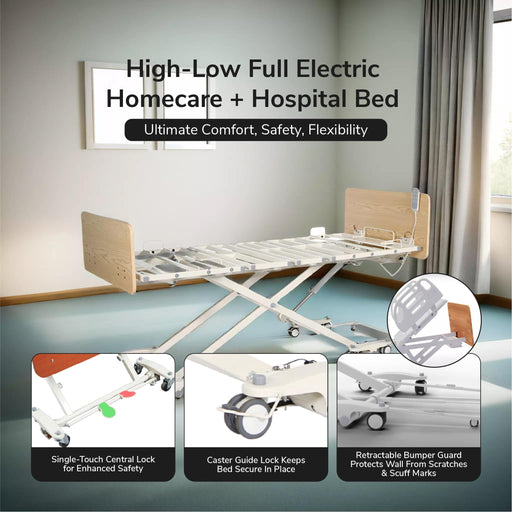
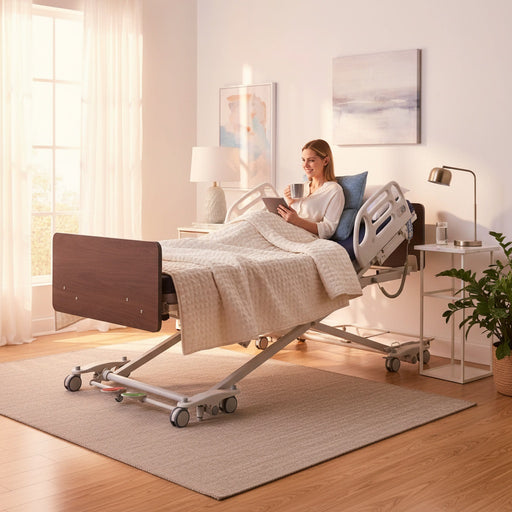
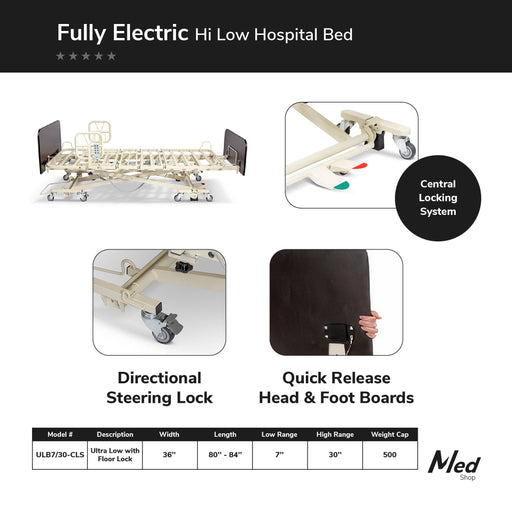
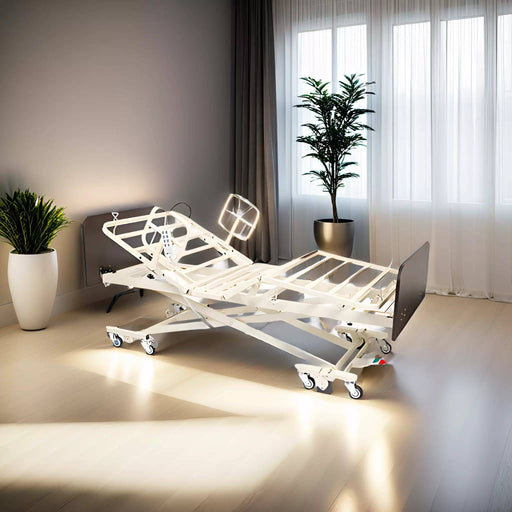


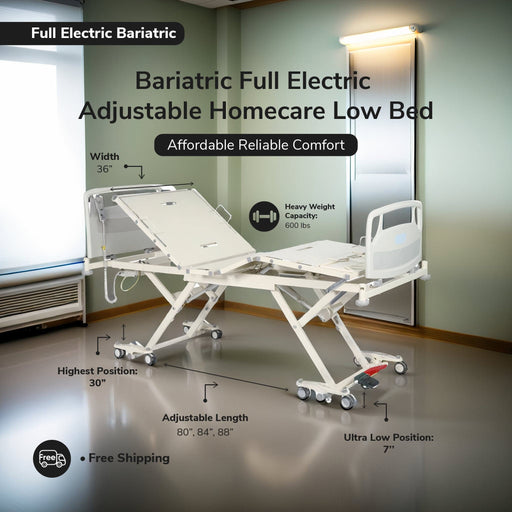
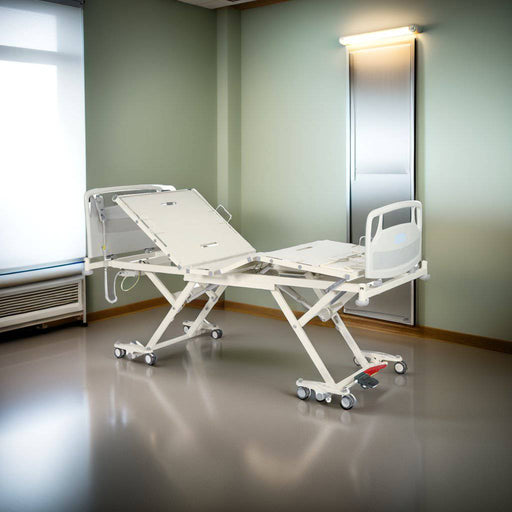
Leave a comment